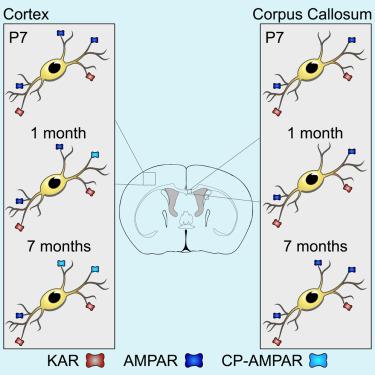少突胶质前体细胞AMPA受体随年龄和脑区不同而不同,而蓝酸盐受体保持稳定
IF 4.1
2区 综合性期刊
Q1 MULTIDISCIPLINARY SCIENCES
引用次数: 0
摘要
少突胶质前体细胞(OPCs)在整个生命过程中增殖并分化为髓鞘少突胶质细胞。许多信号调节OPC的增殖和分化,包括神经元活动,OPC通过电压门控离子通道和谷氨酸受体感知。然而,OPCs在这些通道和受体的膜表面表达上表现出区域和时间的多样性,改变了它们感知和响应神经元活动的能力。在此,我们使用全细胞膜片钳在急性脑切片和浴敷3 μM kainate或10 μM AMPA来研究kainate和AMPA受体膜表面表达的异质性。我们发现,虽然盐酸盐受体电流密度随年龄保持稳定,但OPCs对神经元盐酸盐受体特异性药物没有反应。相比之下,AMPA受体电流密度随年龄和不同区域而不同,可能是由于Ca2+通透性改变和受体脱敏。OPCs中ampa诱发电流的时间变化与报道的年龄相关的增殖和分化电位变化相关。本文章由计算机程序翻译,如有差异,请以英文原文为准。

Oligodendrocyte precursor cell AMPA receptors differ with age and brain region while kainate receptors remain stable
Oligodendrocyte precursor cells (OPCs) proliferate and differentiate into myelinating oligodendrocytes throughout life. Many cues modulate OPC proliferation and differentiation, including neuronal activity, which OPCs sense through voltage-gated ion channels and glutamate receptors. However, OPCs display regional and temporal diversity in the membrane surface expression of these channels and receptors, altering their capacity to sense and respond to neuronal activity. Here, we use whole-cell patch-clamp in acute brain slices and bath-apply 3 μM kainate or 10 μM AMPA to investigate the heterogeneity in kainate and AMPA receptor membrane surface expression. We find that, while kainate receptor current density remains stable with age, OPCs do not respond to neuronal kainate receptor-specific drugs. In contrast, AMPA receptor current density differs with age and between regions, likely due to altered Ca2+ permeability and receptor desensitization. The temporal changes in AMPA-evoked currents in OPCs correlate with reported age-related changes in proliferation and differentiation potential.
求助全文
通过发布文献求助,成功后即可免费获取论文全文。
去求助
来源期刊

iScience
Multidisciplinary-Multidisciplinary
CiteScore
7.20
自引率
1.70%
发文量
1972
审稿时长
6 weeks
期刊介绍:
Science has many big remaining questions. To address them, we will need to work collaboratively and across disciplines. The goal of iScience is to help fuel that type of interdisciplinary thinking. iScience is a new open-access journal from Cell Press that provides a platform for original research in the life, physical, and earth sciences. The primary criterion for publication in iScience is a significant contribution to a relevant field combined with robust results and underlying methodology. The advances appearing in iScience include both fundamental and applied investigations across this interdisciplinary range of topic areas. To support transparency in scientific investigation, we are happy to consider replication studies and papers that describe negative results.
We know you want your work to be published quickly and to be widely visible within your community and beyond. With the strong international reputation of Cell Press behind it, publication in iScience will help your work garner the attention and recognition it merits. Like all Cell Press journals, iScience prioritizes rapid publication. Our editorial team pays special attention to high-quality author service and to efficient, clear-cut decisions based on the information available within the manuscript. iScience taps into the expertise across Cell Press journals and selected partners to inform our editorial decisions and help publish your science in a timely and seamless way.
 求助内容:
求助内容: 应助结果提醒方式:
应助结果提醒方式:


